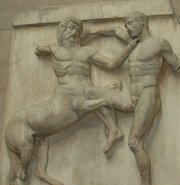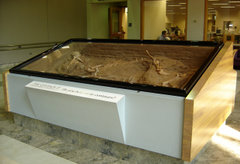Centaur
In Greek mythology, the centaurs (Greek: Κένταυροι) are a race part human and part horse, with a horse's body and a human head and torso. more...
The general character of centaurs is that of wild, lawless and inhospitable beings, the slaves of their animal passions. more...
Two exceptions to this rule were Pholus and Chiron, who expressed their "good" nature, wise and kind centaurs. They are variously explained by a fancied resemblance to the shapes of clouds, or as spirits of the rushing mountain torrents or winds.
Dwelling in the mountains of Thessaly, the centaurs were the offspring of Ixion and Nephele, the rain-cloud. Alternatively, the centaurs were the offspring of Kentauros (the son of Ixion and Nephele) and some Magnesian mares or of Apollo and Hebe. It was sometimes said that Ixion planned to have sex with Hera but Zeus prevented it by fashioning a cloud in the shape of Hera. Since Ixion is usually considered the ancestor of the centaurs, they may be referred to by poets as the Ixionidae.
The Centaurs are best known for their fight with the Lapithae, caused by their attempt to carry off Hippodamia (a "horse" woman herself) on the day of her marriage to Peirithous, king of the Lapithae, himself the son of Ixion. The strife among these cousins is a metaphor for the conflict between the lower appetites and civilized behavior in humankind. Theseus, who happened to be present, a hero and founder of cities, threw the balance in favor of the right order of things, and assisted Pirithous. The Centaurs were driven off (Plutarch, Theseus, 30; Ovid, Metamorphoses xii. 210; Diodorus Siculus. iv. 69, 70). Vignettes of the battle between Lapiths and Centaurs were sculpted in bas-relief on the frieze of the Parthenon, which was dedicated to wise Athena.
Like the Titanomachy, the defeat of the Titans by the Olympian gods, the contests with the Centaurs typify the struggle between civilization and barbarism.
Among the centaurs, the third one with an individual identity is Nessus. The mythological episode of the centaur Nessus carrying off Deianira, the bride of Heracles, also provided Giambologna (1529-1608), a Flemish sculptor whose career was spent in Italy, splendid opportunities to devise compositions with two forms in violent interaction. He made several versions of Nessus carrying off Deianira, represented by examples in the Louvre, the Grünes Gewölbe, Dresden, the Frick Collection, New York and the Huntington Library, San Marino, California. His followers, like Adriaen de Vries and Pietro Tacca, continued to make countless repetitions of the subject. When Belleuse tackled the same play of forms in the 19th century, (illustration right) he titled it Abduction of Hippodameia .
In early Attic vase-paintings centaurs were represented as human beings in front, with the body and hind legs of a horse attached to the back; later, they were men only as far as the waist. The battle with the Lapithae, and the adventure of Heracles with Pholus (Apollodorus, ii. 5; Diod. Sic. IV, li) are favourite subjects of Greek art (see Sidney Colvin, Journal of Hellenic Studies, I, 1881, and the exhaustive article in Roscher's Ausführliches Lexikon der griechischen und römischen Mythologie).
Theories of origin
The armchair anthropologist and writer Robert Graves speculated that the Centaurs of Greek myth were a dimly-remembered, pre-Hellenic fraternal earth cult who had the horse as a totem. A similar theory was incorporated into Mary Renault's The Bull from the Sea.
Other sources speculate that the idea of centaurs came from the first reaction of a non-riding culture, as in the Minoan Aegean world, to nomads who were mounted on horses. The theory goes that such riders would appear as half-man, half-animal. Horse taming and horseback culture evolved first in the southern steppe grasslands of Central Asia, perhaps approximately in modern Kazakhstan.
Of the various Classical Greek authors who mentioned centaurs, Pindar was the first who describes undoubtedly a combined monster. Previous authors (Homer etc) only use words that could also mean ordinary men riding ordinary horses.
The Greek word kentauros could be etymologized as ken - tauros = "piercing bull". Some say that the Greeks took the constellation of Centaurus, and also its name "piercing bull", from Mesopotamia, where it symbolized the god Baal who represents rain and fertility, fighting with and piercing with his horns the demon Mot who represents the summer drought. (In Greece, Mot became the constellation of Lupus.) Later in Greece, the constellation of Centaurus was reinterpreted as a man riding a horse, and linked to legends of Greece being invaded by tribes of horsemen from the north. The idea of a combined monster may have arisen as an attempt to fit the pictorial figure to the stars better.
Centaurs in modern fiction
Centaurs have appeared many times and in many places in modern times, in for example Artemis Fowl, Fantasia, the Narnia books, and Harry Potter. There is also a Digimon named Centarumon.
In fantasy novels the view of centaurs has been changed from barbarism to an honorable race that practices breeding and other actions relative to that of animals. Though the Greek word kentauros is said to be composed of a single morpheme— perhaps not a Greek one in its origin—, a suffix -taur has been invented by writers and game designers in the late 20th century for other fantasy animal-human hybrids. For more information, see the article Taur.
Read more at Wikipedia.org




